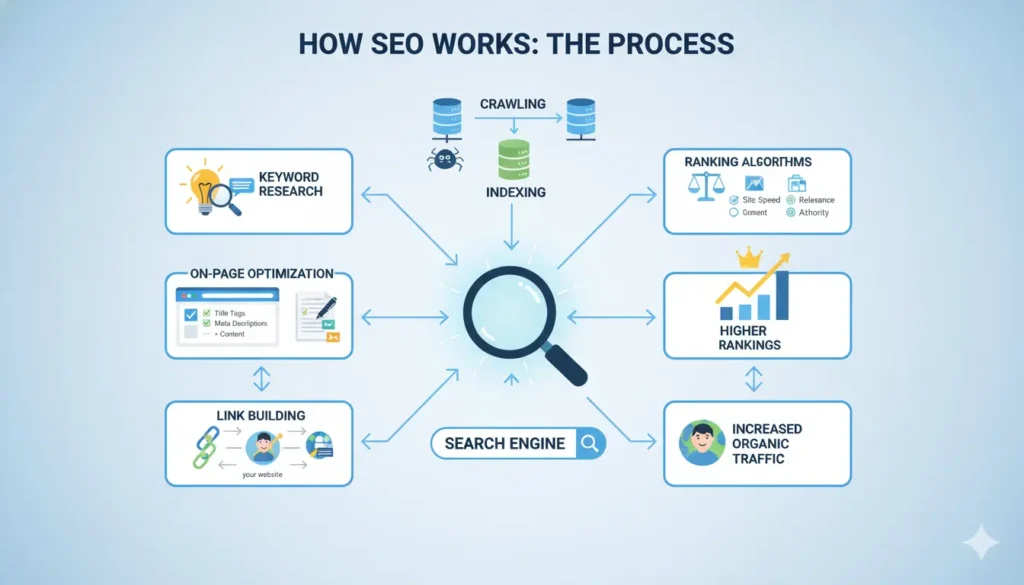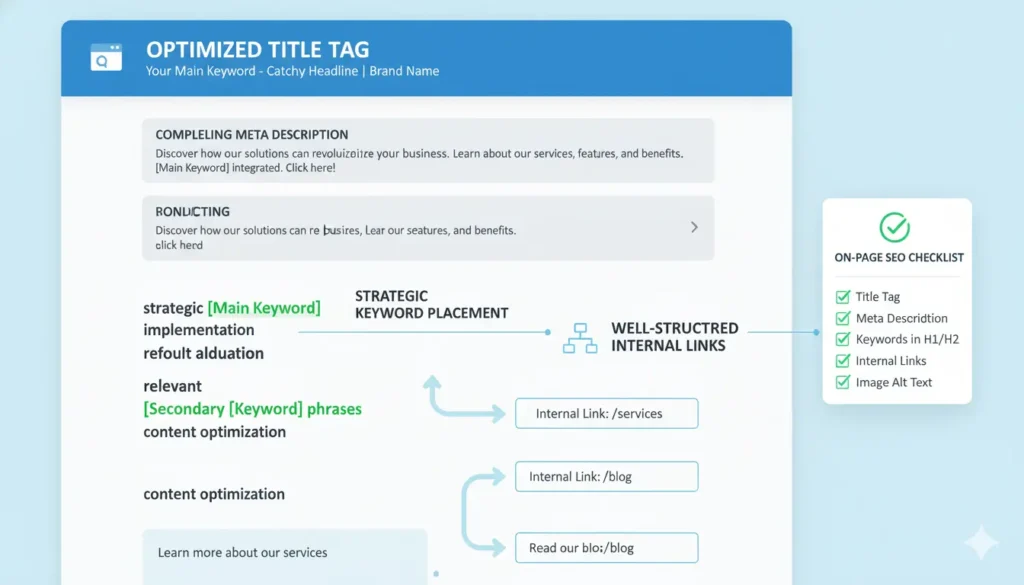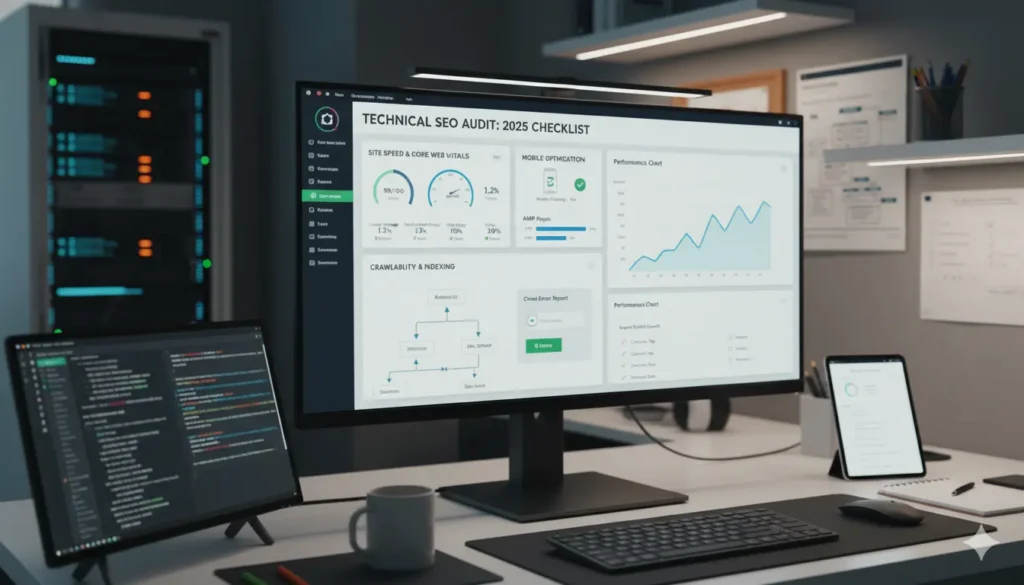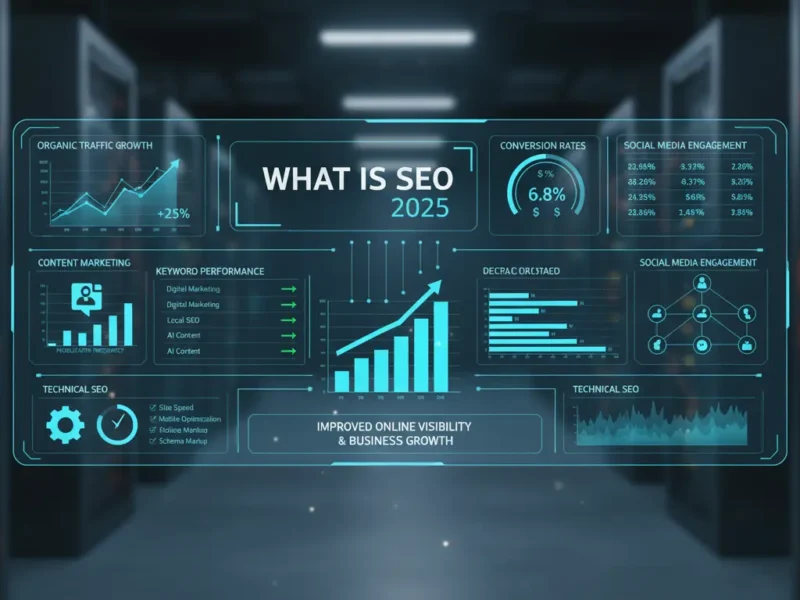If you’ve ever asked yourself “What Is SEO and why does every growth‑focused company talk about it?” here’s a curiosity spark: more than half of website sessions for many businesses still start with an organic search, yet most teams only use a fraction of what modern SEO can do. In 2025, search results are richer, faster, and more competitive than ever. The winners aren’t gaming algorithms they’re the brands that make it easy for search engines to understand their pages and even easier for people to find, trust, and act.
This guide answers What Is SEO in plain language. You’ll learn how search works, the pillars of strong SEO (on‑page, technical, off‑page, content, local, ecommerce), how to map keywords to intent, the essentials of structured data and Core Web Vitals, and the metrics that prove your effort is paying off. You’ll also get checklists, examples, and FAQs you can use with your team today.
Table of Contents
What Is SEO? A Definition You Can Share
What Is SEO? Search Engine Optimization is the discipline of making your website easier for search engines to understand and for users to find and use so your pages appear for the right searches, earn clicks, and convert. It’s not tricks or shortcuts. It’s the consistent application of relevance (matching search intent), quality (useful, trustworthy content), and performance (fast, accessible pages) to create long‑term results that compound.

In practice, SEO spans:
- On‑page: content, titles, headings, internal links, images, structured data
- Technical: site architecture, crawlability, indexation, speed, mobile, canonicalization
- Off‑page: links, brand mentions, reviews, reputation
- Local & ecommerce specifics: profiles, location/product data
- Measurement: Search Console, analytics, KPIs tied to revenue
When teams ask “What Is SEO in digital marketing?”, the most accurate answer is: it’s how you turn questions into customers.
Why SEO Matters in 2025 (and What Changed)
- Richer results: Search pages show overviews, carousels, videos, FAQs, and product data. If your page is structured clearly, you can earn more real estate and better click‑through.
- Zero‑click behavior: Many users get enough context from results to decide. Clear snippets, accurate metadata, and structured data make your listing the obvious choice.
- Mobile‑first world: Phones dominate local and commercial searches. Speed, simple layouts, and tap‑friendly design are mandatory.
- Trust above all: Experience, credentials, reviews, and transparent policies (E‑E‑A‑T) influence which pages are surfaced especially for sensitive topics.
- Budget pressure: Organic traffic reduces paid dependence and smooths cost spikes, improving marketing ROI across the board.
In other words, What Is SEO in 2025? It’s not just “ranking” anymore it’s qualified visibility and helpful experiences that deliver compounding returns.
How Search Works (Crawl → Render → Index → Rank)
A quick primer helps align teams:
- Crawl — Search engines discover pages via links and sitemaps. Your robots.txt influences what gets fetched.
- Render — The content (including JavaScript) is processed to understand what the page actually shows.
- Index — Pages deemed valuable are stored and made available to searchers. Canonical tags help avoid duplicates.
- Rank — For each query, the system evaluates relevance, quality, freshness, location, device, and other signals to decide which pages appear.
Your job: make it simple to crawl, clear to understand, worth indexing, and the best answer to show.
The Pillars of SEO
Think of these as interconnected levers:
- On‑page SEO: Titles, headings, descriptive copy, internal links, images, and structured data aligned to intent.
- Technical SEO: Clean architecture, crawl & index control, mobile performance, Core Web Vitals, canonicalization, redirects.
- Off‑page SEO: Quality links, relevant mentions, reviews, and reputation that confirm authority.
- Content & Experience: Helpful, organized content with clear navigation and calls‑to‑action; accessibility and speed.
- Measurement: Search Console + analytics to track impressions, clicks, conversions, and revenue.
Every win starts with on‑page clarity and technical reliability, then accelerates with off‑page trust.
Search Intent & Keyword Research (Mapping Queries to Actions)
Great SEO starts with intent what the searcher is trying to accomplish:
- Informational: learn (“what is…”, “how to…”)
- Commercial investigation: compare options (“best…”, “vs…”, “reviews”)
- Transactional: do or buy (“price”, “near me”, “book”, “download”)
- Navigational: find a specific site or brand
A practical research flow
- Pull your current queries from Search Console; identify winners and near‑winners.
- Expand topics with a keyword tool; group by intent and funnel stage.
- Map each cluster to a page type (guide, comparison, service/product, location).
- Prioritize by potential business impact (volume × intent × conversion likelihood).
- Write title tags and headings that mirror the query no vague jargon.
The most important step: ensure one page = one main purpose. Don’t make one page do ten jobs.
On‑Page SEO Essentials (With Mini‑Checklist)

Titles & Meta Descriptions
- Title: 50–60 characters, place key phrase naturally, promise a clear benefit.
- Meta description: support the title with a compelling reason to click (≤155 characters).
- Match your target query’s language (e.g., include “What Is SEO” if that’s the page’s purpose).
Headings & Structure
- H1 reflects the page’s main promise (unique per page).
- H2/H3 break content into logical sections (problems, steps, FAQs, proof).
- Add a table of contents with jump links on long pages.
Copy & Calls‑to‑Action
- Write for people first: plain language, examples, steps.
- Use bullets for scannability; add visuals where they reduce cognitive load.
- Place clear calls‑to‑action in context (download, book, compare, contact).
Internal Links
- Link between related pages with descriptive anchor text (“technical SEO checklist” not “click here”).
- From high‑traffic pages, add links to key converting pages.
- Ensure every important page is reachable in 3–4 clicks from the homepage.
Images & Media
- Compress images; serve modern formats (WebP/AVIF).
- Use descriptive alt text (helpful for accessibility and image search).
- Include short videos where they clarify process or proof.
Schema (Structured Data)
- Add relevant markup to qualify for rich results (FAQ Page, How To, Product, Article, Local Business, Breadcrumb List).
- Ensure markup matches visible content; validate with the Rich Results Test.
On‑Page Mini‑Checklist
- Clear title & meta description
- One H1; logical section headings
- Intent‑aligned copy with examples
- Descriptive internal links
- Optimized images & alt text
- Relevant structured data
- Obvious next step (CTA)
Technical SEO Fundamentals (Make it Easy to Be Found)

Architecture & Crawl Control
- Flat, logical site structure; avoid deep nesting for key pages.
- Submit an XML sitemap in Search Console; keep it clean (indexable URLs only).
- Use robots.txt to block non‑public sections (not to hide indexed pages).
Canonicalization & Duplicates
- Add rel=”canonical” on variants and paginated content.
- Avoid parameter‑driven duplicates (use canonical or parameter handling).
- Enforce one primary URL per page (http→https, www→non‑www, trailing slash policy).
Indexation & Redirects
- Monitor coverage in Search Console; fix soft 404s and unexpected “excluded” pages.
- Use 301 redirects for moved content; avoid redirect chains.
- Keep 404 pages useful with navigation and search.
Core Web Vitals & Mobile Performance
- LCP (Largest Contentful Paint): optimize hero images; prioritize loading.
- INP (Interaction to Next Paint): reduce long tasks; minimize render‑blocking scripts.
- CLS (Cumulative Layout Shift): reserve space for images/fonts; avoid late‑loading banners.
JavaScript & Rendering
- Where possible, render primary content server‑side or via hydrated content; ensure important content/links are visible in the HTML.
- Provide fallback content; avoid requiring user interaction to load core content.
Internationalization (if relevant)
- Implement hreflang for different languages/regions; ensure correct URLs and reciprocation.
- Localize content; don’t just translate titles.
Technical Mini‑Checklist
- Clean sitemap & robots.txt
- Canonicals set correctly
- No duplicate content issues
- 301s for moved pages; minimal chains
- Passing Core Web Vitals (field data)
- Crawlable main content & links
Off‑Page & Reputation (Links, Mentions, Reviews, E‑E‑A‑T)
Off‑page signals answer “Why your page?” when multiple pages are relevant.
- Links & mentions: earn editorial links from relevant sites industry publications, associations, partners, local media. Focus on quality and context, not raw counts.
- Digital PR: publish data studies, helpful tools, or step‑by‑step proof that others want to cite.
- Reviews: for local and ecommerce, review volume, recency, and thoughtful responses influence both rankings and conversion.
- E‑E‑A‑T: show Experience, Expertise, Authoritativeness, and Trust real author bios, credentials, case studies with numbers, transparent policies and contact details.
Avoid shortcuts (link schemes, “private networks”). Sustainable authority comes from being genuinely helpful and visible.
Content Strategy That Compounds (Topical Authority & Hubs)
Search engines reward depth and organization.
- Choose themes that align to revenue (e.g., CRM selection, dental implants, running shoes).
- Build a pillar page for each theme (ultimate guide).
- Add 6–10 cluster pages targeting subtopics (how‑tos, comparisons, FAQs).
- Interlink pillar ↔ clusters with descriptive anchors.
- Refresh high‑value pages quarterly with new examples, data, and FAQs.
Great content answers real questions with first‑hand proof: screenshots, data tables, photos, timelines show your work.
Local SEO (Map Pack, Reviews, Location Pages)
If you have a physical presence or service area:
- Google Business Profile: specific category, services with descriptions, accurate hours, photos, booking links; post occasional updates.
- Reviews: ask after positive interactions (QR code, short link); reply to all.
- Location pages: unique per location; include directions, parking, nearby landmarks, staff photos, and CTAs.
- Citations: consistent name, address, phone across directories; fix duplicates.
Local SEO is part of “What Is SEO” because for many businesses it’s where search meets the real world.
Ecommerce SEO (Product, Category, Filters, Structured Data)
- Product pages: unique descriptions, high‑quality images, FAQs, reviews, and Product + Offer markup.
- Category pages: informative copy that helps users choose; internal links to top products; avoid thin pages.
- Filters: prevent duplicate content with canonical tags or parameter handling; keep important filtered views indexable when they match real intent.
- Faceted navigation: allow search engines to crawl only valuable combinations; block crawl traps.
- Feed quality: clear titles and structured product data support both SEO and Shopping ads.
International SEO (Hreflang, Localization, Pitfalls)
- Implement hreflang for language/region variants; ensure reciprocal links and correct ISO codes.
- Localize beyond translation: measurements, currencies, examples, and policies.
- Serve pages from ccTLDs or subfolders; be consistent with your structure.
SERP Features & Structured Data (Win More Real Estate)
Structured data enhances your eligibility for rich features:
- FAQPage: add to genuine FAQs; avoid site‑wide spam.
- HowTo: step‑based, non‑sensitive instructions with visible steps.
- Breadcrumb List: communicate site hierarchy and improve snippets.
- Article/BlogPosting: show headline, author, and dates in results.
- Product/Offer/AggregateRating: price, availability, and rating (must match visible page).
- LocalBusiness: NAP info, hours, geo coordinates.
Validate with the Rich Results Test and monitor Search Console Enhancements.
Measurement: Search Console, Analytics, KPIs, Attribution
Search Console
- Queries, impressions, CTR, average position
- Page coverage & indexing issues
- Sitemaps and Core Web Vitals reports
Analytics (e.g., GA4)
- Organic sessions, conversions, revenue
- Landing page performance
- Assisted conversions and path analysis
KPIs
- Leading: impressions, CTR, ranking distribution (Top 3/10/50), Core Web Vitals pass rate
- Lagging: organic conversions, revenue, leads qualified (for B2B), cost savings vs paid
Attribution
- Don’t rely on one source of truth; compare platform and analytics views.
- Use UTMs to distinguish campaigns and content.
- Align SEO KPIs with business outcomes (bookings, orders, MQL/SQL progression).
Report monthly: what changed, what worked, and what you’re improving next.
Tools (Keep It Lean)
- Search Console and Analytics for measurement
- Crawlers: Screaming Frog or Sitebulb for audits and internal links
- Performance: PageSpeed Insights, Lighthouse for Core Web Vitals
- Keyword research: a reputable tool + Search Console data
- Log analysis: optional for large/JS‑heavy sites
- Schema validators: Rich Results Test, Schema Markup Validator
Buy tools to support a process, not in place of one.
Common Myths & Mistakes (and the Fix)
- Myth: SEO is about stuffing keywords.
Fix: Write for intent; place phrases naturally in titles, headings, and copy. - Myth: More pages = better rankings.
Fix: Quality beats quantity. Consolidate thin pages; refresh evergreen content. - Myth: Buying links guarantees success.
Fix: Earn relevant links with useful assets; avoid risky schemes. - Mistake: Sending all traffic to the home page.
Fix: Build focused pages that answer the query and include a clear CTA. - Mistake: Ignoring mobile speed.
Fix: Compress images, minimize scripts, prioritize LCP. - Mistake: “Set and forget.”
Fix: Review monthly; refresh content; monitor Search Console for changes. - Mistake: Measuring only rankings.
Fix: Track clicks, conversions, and revenue tied to target pages.
Executive‑Level Checklist (5 Actions That Move the Needle)
- Define intent for your top 10 pages; align titles, H1s, and CTAs accordingly.
- Fix Core Web Vitals on key templates; compress hero images and reduce render‑blocking scripts.
- Add structured data (FAQ, Breadcrumb, Product/Article/LocalBusiness) where relevant.
- Improve internal links from high‑traffic posts to service/product pages with descriptive anchors.
- Polish your Google Business Profile and launch a simple review request habit (for local businesses).
Small steps, significant compounding.
Conclusion: Turn “What Is SEO” Into a System You Trust
By now, What Is SEO should feel less like a buzzword and more like a dependable system: match intent, deliver helpful content, structure pages clearly, ensure technical reliability, and earn trust from the wider web. In 2025, that’s how you win richer results, better click‑through, and more conversions without chasing fads.
Ready to Rank Higher & Grow Your Business Online?
SEO isn’t just about keywords it’s about building long-term visibility, trust, and consistent traffic that converts.
At SparXcellence Ghodke’s LLP, we help businesses dominate Google and turn visitors into paying customers with:
✔ Custom SEO strategies
✔ Local SEO optimization
✔ On-page & technical SEO
✔ High-quality content planning
✔ Monthly reporting & growth tracking
➡️ Book Your FREE SEO Consultation Today
Let’s analyze your website, fix SEO issues, and create your 2025 growth roadmap.
👉 Schedule your consultation here:
https://ghodkes.com/contact-us/
FAQs
What Is SEO in one sentence?
It’s the practice of making your website the best answer for specific searches so it’s easy for search engines to understand and for people to find, trust, and act.
How long does SEO take?
Initial improvements (CTR, indexing, Core Web Vitals) can show within weeks; durable gains often build over 2–3 months and compound each quarter.
Is SEO better than paid ads?
They serve different roles. Paid captures demand immediately; SEO builds qualified visibility that reduces dependence on ad spend and improves conversion across all channels.
Do backlinks still matter?
Yes but quality and relevance matter far more than volume. Focus on links from sites your audience trusts.
How do we prove ROI from SEO?
Tie organic sessions and conversions to target pages, track assisted conversions, and compare outcomes before/after changes in Search Console and analytics.








